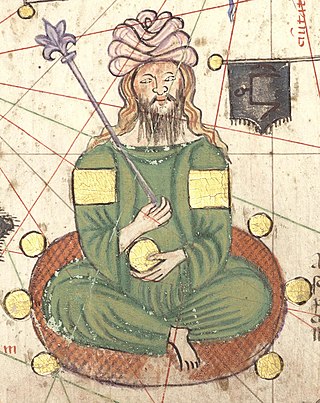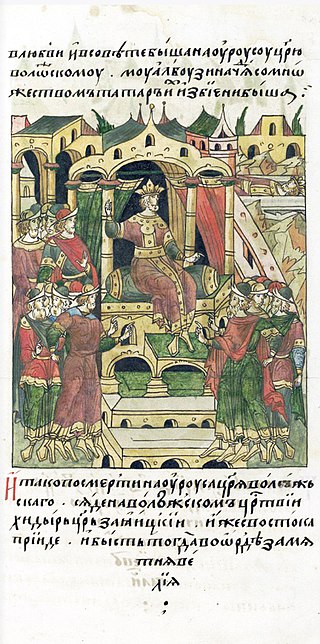
Giyasuddin Muhammad Uzbek Khan, better known as Uzbeg, Uzbek or Ozbeg (1282–1341), was the longest-reigning khan of the Golden Horde (1313–1341), under whose rule the state reached its zenith. He was succeeded by his son Tini Beg. He was the son of Toghrilcha and grandson of Mengu-Timur, who had been khan of the Golden Horde from 1267 to 1280.

Sarai was the name of possibly two cities near the lower Volga, that served successively as the effective capitals of the Cuman–Kipchak Confederation and the Golden Horde, a Turco-Mongol kingdom which ruled much of Northwestern Asia and Eastern Europe, from the 10th through the 14th century. There is considerable disagreement among scholars about the correspondence between specific archaeological sites and the various references to سرای, (Sarāy); سرای باتو ; سرای برکه, ; سرای الجدید, ; and سرای المحروسه in the historical sources.

Jani Beg, also known as Janibek Khan, was Khan of the Golden Horde from 1342 until his death in 1357. He succeeded his father Öz Beg Khan.
Urus Khan was the eighth Khan of the White Horde and a disputed Khan of the Blue Horde; he was a direct descendant of Genghis Khan. Urus himself was the direct ancestor of the khans of the Kazakh Khanate.
Temür Qutlugh or Tīmūr Qutluq (Kypchak: تمور قوتلو; Turki/Persian: تیمور قتلغ; was Khan of the Golden Horde from 1397 to 1399.

Berdi Beg or Berdibek was Khan of the Golden Horde from 1357 to 1359, having succeeded his father Jani Beg. Berdi Beg was the last khan to rule before the beginning of a long cycle of civil wars in the Golden Horde.

Nawruz Beg was Khan of the Golden Horde in 1360.
Küchük Muḥammad, also spelled Kīchīk Muḥammad was Khan of the Golden Horde from 1433 until his death in 1459. He was the son of Tīmūr Khan, possibly by a daughter of the powerful beglerbeg Edigu. His name, "Little Muḥammad," was intended to distinguish him from a rival and older contemporary, Ulugh Muḥammad, "Big Muḥammad."

Khiḍr Khan was Khan of the Golden Horde from 1360 to 1361, having overthrown and succeeded Nawruz Beg.
Kildi Beg was Khan of the Golden Horde in 1361–1362, having replaced his rival Ordu Malik.

Taydula Khatun was a queen consort of the Mongol Golden Horde as the wife of Öz Beg Khan and possibly Nawruz Beg Khan. She was also the mother of the khans Tini Beg and Jani Beg, and the grandmother of Berdi Beg. The favorite of her husband, she gained and retained a lasting importance during the reigns of her sons and grandson, and attempted to hold on to power by appointing the latter's successors.
Murād Khan ; called Amurat and Murut in Russian sources, and sometimes Murīd/Mürid, Burut, and Murdād in eastern sources, was Khan of at least part of the Golden Horde from 1361 to 1363)
Īl Beg (Īl-Bīk) was an ephemeral khan of the Golden Horde in 1374, during a period of civil war. The westernmost portion of the Golden Hode was under the control of the beglerbeg Mamai and his puppet khan Muḥammad-Sulṭān, while the easternmost portion was under the control of Urus Khan. There is very little information about this ruler, but his name is found or rationalized in several different forms.
Qāghān Beg was Khan of the Golden Horde from 1375 to 1377. He held the traditional capital Sarai during a period of civil war among rival contenders for the throne. Throughout his reign, the westernmost portion of the Golden Horde was under the control of the beglerbeg Mamai and his puppet khan Muḥammad-Sulṭān, while the easternmost portion was under the control of Urus Khan and then his sons.

ʿArab Shāh was khan of the Golden Horde in 1377–1380. He held the traditional capital Sarai during a period of civil war among rival contenders for the throne. Throughout his reign, the westernmost portion of the Golden Hode was under the control of the beglerbeg Mamai and his puppet khans, while the easternmost portion was under the control of the sons of Urus Khan and then Tokhtamysh.
Khayr Pūlād or Mīr Pūlād was khan of the Golden Horde in 1362–1364. He held the traditional capital Sarai during a period of civil war among rival contenders for the throne. Throughout his reign, the westernmost portion of the Golden Hode was under the control of the beglerbeg Mamai and his puppet khan ʿAbdallāh, while the easternmost portion was under the control of the heirs of Qara Nogai.

Tīmūr or Temür was Khan of the Golden Horde from 1410 to 1412, in the waning days of the khanate.
Qādir Berdi was briefly the khan of the Golden Horde in 1419.
Quyurchuq (Qūyūrčuq) was the khan of the Golden Horde in 1395–1397, appointed by Timur (Tamerlane). Information on his life and reign is very limited.









